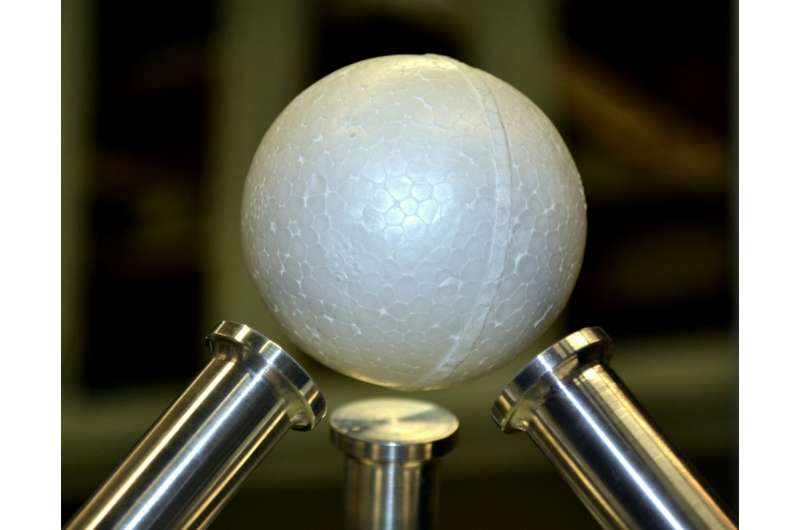Acoustic levitation of a polystyrene sphere, the first spherical object to be acoustically levitated that is larger than the acoustic wavelength. Credit: Andrade et al. ©2016 AIP Publishing
When placed in an acoustic field, small objects experience a net force that can be used to levitate the objects in air. In a new study, researchers have experimentally demonstrated the acoustic levitation of a 50-mm (2-inch) solid polystyrene sphere using ultrasound—acoustic waves that are above the frequency of human hearing.
The demonstration is one of the first times that an object larger than the wavelength of the acoustic wave has been acoustically levitated. Previously, this has been achieved only for a few specific cases, such as wire-like and planar objects. In the new study, the levitated sphere is 3.6 times larger than the 14-mm acoustic wavelength used here.
The researchers, Marco Andrade and Julio Adamowski at the University of São Paulo in Brazil, along with Anne Bernassau at Heriot-Watt University in Edinburgh, UK, have published a paper on the acoustic levitation demonstration in a recent issue of Applied Physics Letters.
"Acoustic levitation of small particles at the acoustic pressure nodes of a standing wave is well-known, but the maximum particle size that can be levitated at the pressure nodes is around one quarter of the acoustic wavelength," Andrade told Phys.org. "This means that, for a transducer operating at the ultrasonic range (frequency above 20 kHz), the maximum particle size that can be levitated is around 4 mm. In our paper, we demonstrate that we can combine multiple ultrasonic transducers to levitate an object significantly larger than the acoustic wavelength. In our experiment, we could increase the maximum object size from one quarter of the wavelength to 50 mm, which is approximately 3.6 times the acoustic wavelength."
Although there are several different ways to acoustically levitate an object, most methods use an ultrasonic transducer, which converts electrical signals into ultrasonic waves. The current setup uses three ultrasonic transducers arranged in a tripod fashion around the sphere.
As the researchers explain, the angle and number of transducers can be changed, and this does not interfere with the setup's ability to levitate a large object. The ability to levitate the large sphere occurs because the three transducers produce a standing wave in the space between the transducers and the sphere. In previous methods, small objects are levitated by being trapped at the pressure nodes of the standing wave, but this is not the case here.
Demonstration of the acoustic levitation of a polystyrene sphere using ultrasound waves. Credit: Andrade et al. ©2016 AIP Publishing
"In a typical acoustic levitation device, a small particle can be levitated at the pressure node of a standing wave formed between the transducer and a reflector," Andrade explained. "Instead of trapping the object at the pressure node, the key to levitating an object larger than the acoustic wavelength is to generate a standing wave between the transducer and the object."
Although this strategy is based on earlier work, the tripod arrangement used here provides greater 3D stability.
"The idea of levitating an object larger than the acoustic wavelength was based on the paper of Zhao and Wallaschek," Andrade said. "In their paper, they showed that a large planar object can be levitated by generating a standing wave between the object and the transducer. However, their setup was only capable of providing vertical acoustic forces, and they used a central pin in contact with the object to prevent it from escaping laterally. By using three ultrasonic transducers in a tripod configuration, we obtain vertical and lateral acoustic forces. Consequently, we can levitate an object larger than the acoustic wavelength without any contact with external surfaces."
Using the new method, the researchers demonstrated that the sphere could be levitated to a height of about 7 mm, or approximately half the wavelength of the acoustic waves. They predict that the method can be used to levitate even larger spheres, and can also be extended to levitate objects of different shapes and sizes and at different positions.
"At the moment, we can only levitate the object at a fixed position in space," Andrade said. "In future work, we would like to develop new devices capable of levitating and manipulating large objects in air."
Acoustic levitation has applications for handling and manipulating various materials, such as very hot materials and liquid samples in space. In microgravity, the lower surface tension allows liquid droplets to reach larger sizes than they do on Earth, and acoustic levitation can be used to control and analyze these large liquid samples.
More information: Marco A. B. Andrade et al. "Acoustic levitation of a large solid sphere." Applied Physics Letters. DOI: 10.1063/1.4959862
Journal information: Applied Physics Letters
© 2016 Phys.org
























